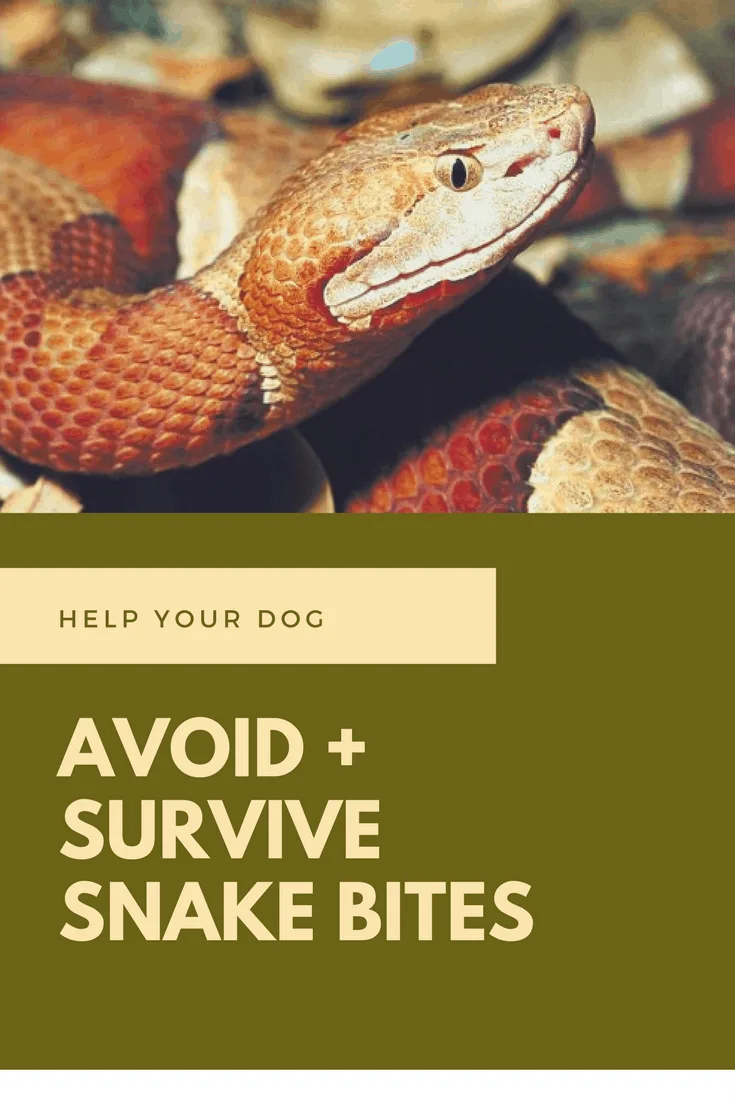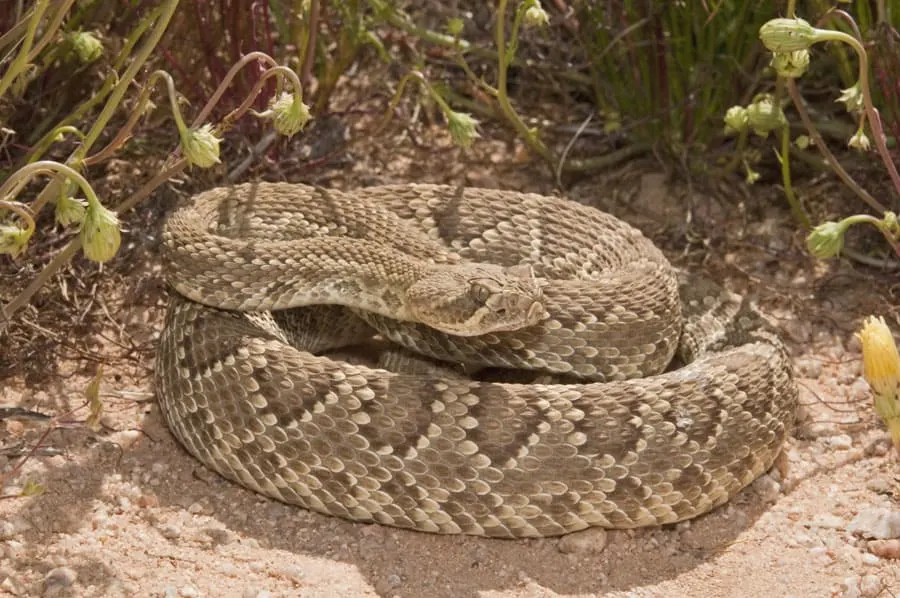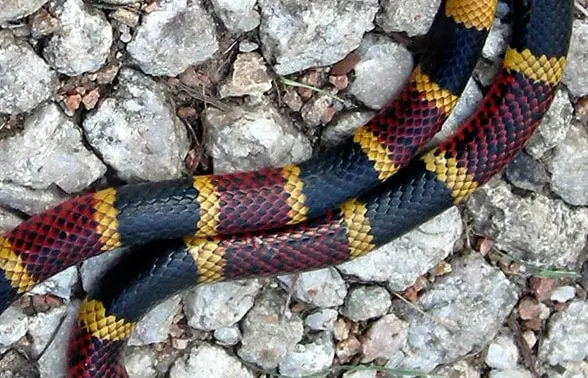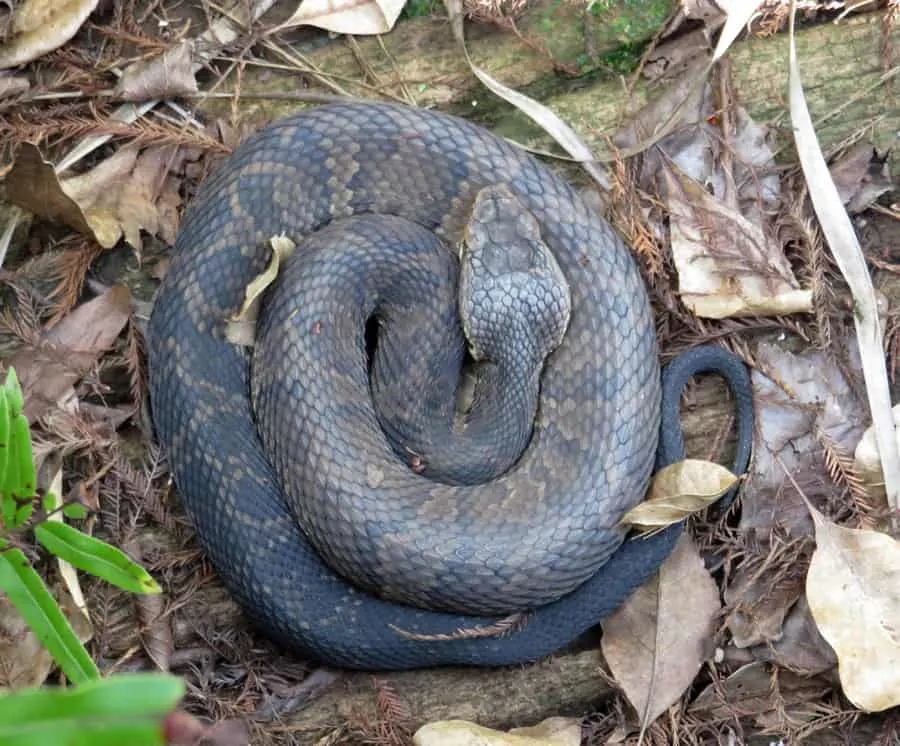Spring and fall months mean snakes–and, in many areas, that means venomous snakes. Did you know that in the US about 90 percent of snakebites occur between April and October? Of course, those months are also the best times to be out walking your dog–so it’s important to avoid snake bites–and know what to do if your dog is bitten by a snake.

Today we’ve got some tips from the California Veterinary Medical Association, the largest state veterinary medical association in the United States, on how you can lessen the chances of your dog getting bitten…and improve your dog’s chance of survival should he be bitten by a snake.
Help your dog avoid snakes
- Avoiding snake habitat is the best way to prevent your dog from being bitten by a snake. [We especially avoid stone ledges and brush piles on our dog walks. Both are perfect snake habitat!]
- Keeping a dog leashed and under control at all times during walks and hikes may prevent perilous encounters with venomous snakes. [Our dogs remain on a four-foot leash on our walks, close enough that I can see what we’re coming up on!]
Dr. Dalton Hindmarsh, a veterinary resident at the Texas A&M College of Veterinary Medicine & Biomedical Sciences, has some additional advice.
“Owners may consider avoidance training (teaching dogs to leave snakes alone) for outdoor and working dogs,” Hindmarsh said. “Keeping pets on a leash may also reduce the chance they encounter a snake.”
Dr. Hindmarsh notes that if pet owners have concerns about their animal encountering snakes, they should contact their veterinarian to discuss how they can best protect their pet.
Snake bite on dogs — What to do if your dog is bitten
You’ve tried your best–but still your dog has been bitten by a snake. What should you do? The CVMA recommends:
- Should your dog get bitten by a snake, walk − do not run − away from it.
- Do not attempt to kill the snake, but make a note of what it looks like, if possible. Veterinarians know of their local population of venomous snakes, and identification is not always essential.
- Immediately make your way to the nearest veterinarian.
- Do not give your dog any over-the-counter medications, and avoid ice, hot/cold packs, sprays, incisions, suctioning, and tourniquets. The signs and symptoms that develop often will guide your veterinarian to the appropriate therapy.
Dr. Dalton Hindmarsh, a veterinary resident at the Texas A&M College of Veterinary Medicine & Biomedical Sciences, has some additional advice.
“First, you should keep your pet calm and seek veterinary care,” he said. “Contrary to what you may read on the internet, I would not recommend giving any medications at home, including things like Benadryl, without first consulting your veterinarian. I would also not recommend a tourniquet or trying to suck the venom out.”
Hindmarsh also said that prophylactic antibiotics are typically not prescribed, since the risk of infection from a snake bite is less than 1 percent.
Steroid medications or non-steroidal anti-inflammatory (NSAID) pain medications are also not usually involved in treatment of a snake bite, as they have a high risk of side effects and no documented treatment benefit.
Hindmarsh adds that snake bites are very common in dogs and less frequently seen in cats.
It’s also important to remember that if a snake is able to harm your pet, they are likely a danger to you as well, so Hindmarsh recommends that owners exercise caution after the bite.
“If the snake is already dead, you can take a picture of it to show veterinary staff,” he said.
“Please do not bring the snake with you! If the snake is alive, do not put yourself in danger and leave the area with your pet.”
Where are Venomous Snakes Found?

It’s important to know the snakes in your area…and know which ones are venomous.

In the US, rattlesnakes are found across the country, while coral snakes are found primarily in Arizona, Texas, and Florida.

Copperheads and water moccasins are found in Eastern and Central U.S., and their bites are the most common due to their proclivity for living near humans, according to Dr. Karl Jandrey, assistant professor at the University of California, Davis School of Veterinary Medicine.

Since we live in an area where all four venomous snakes are found, we’re always on the lookout for snakes on every walk–and in the yard, as well.
Barli found and cornered a rattlesnake on our front porch just a few months after we adopted him, alerting us to the snake with non-stop barks at a safe distance.
In spite of our best efforts, though, our previous dog Yoda was once bitten by a coral snake. Part terrier, he was a dedicated snake and lizard hunter and, while in the front yard, found a coral snake before we did and was struck in the chest. Yoda received veterinary care, survived the bite, and went on to live many more years.
Should My Dog Get the Rattlesnake Vaccine for Dogs?

A while back we received a letter from a dog lover who was considering the rattlesnake vaccine for dogs:
I live about 20 minutes from the veterinarian’s office and about 40 minutes from the emergency vet’s office in a very rural area that has rattlesnakes. Would you recommend getting the rattlesnake vaccine for my dogs? My dogs are often indoors but have access to the fenced yard. Is the rattlesnake vaccine effective for any other kind of poisonous snake bites?
We turned to veterinarian Dr. Audrey Harvey for her advice:
“The rattlesnake vaccine has been available for many years, but there are no controlled studies proving that it is effective, and how long immunity to snake bites lasts.
“However, veterinarians who have treated dogs with snake bite have noted that the dogs have had milder symptoms, and recover quicker. It’s very subjective, because different dogs react to snake bites differently, and there is also a lot of variation in how much venom is injected with each bite.”
“There are risks associated with any vaccines, and with this vaccine, a small percentage of dogs will develop a sterile abscess at the injection site.
“There have also been very few incidences of itchy hives on the skin and anaphylactic reactions (severe allergic reactions), so keep that in mind too.”
“Ultimately it’s up to you whether you feel your dogs are at enough risk to warrant a vaccine. No vaccine is 100% effective. This vaccine won’t stop you dogs getting sick if they are bitten, but it may buy you a bit more time to get them to the vet. They will need an initial series of two vaccines, then yearly boosters.”
“According to the vaccine manufacturer, it offers protection against Western Diamond Rattlesnake, Western Rattlesnake, Sidewinder, Timber Rattlesnake, Massasauga and the Copperhead. It offers partial protection against the Eastern Diamondback Rattlesnake. However, keep in mind my comment that there have been no scientific studies in dogs, so if your dogs are unlucky enough to be bitten, they still need immediate veterinary care.”
So talk to your veterinarian about your dog’s daily activities and travels to make your decision on the rattlesnake vaccine–and for ideas on how you can help avoid snake bites as you and your dog explore!
The purpose of this post is to educate. DogTipper shall have neither liability nor responsibility to any person or entity with respect to any loss or damage caused or alleged to be caused directly or indirectly by this site. This article does not replace the importance of specific advice from your own veterinarian. If you have any concerns at all about your dog’s health, please make an appointment with your vet.
Portions of this article were first published on DogTipper in 2010.
- Review: Jimmy BX7 Pro Anti-Mite Vacuum Cleaner - December 16, 2024
- 🎉 GIVEAWAY: Lord of the Pets Portrait of Your Dog! - November 26, 2024
- Review: Lord of the Pets Portraits - November 17, 2024
